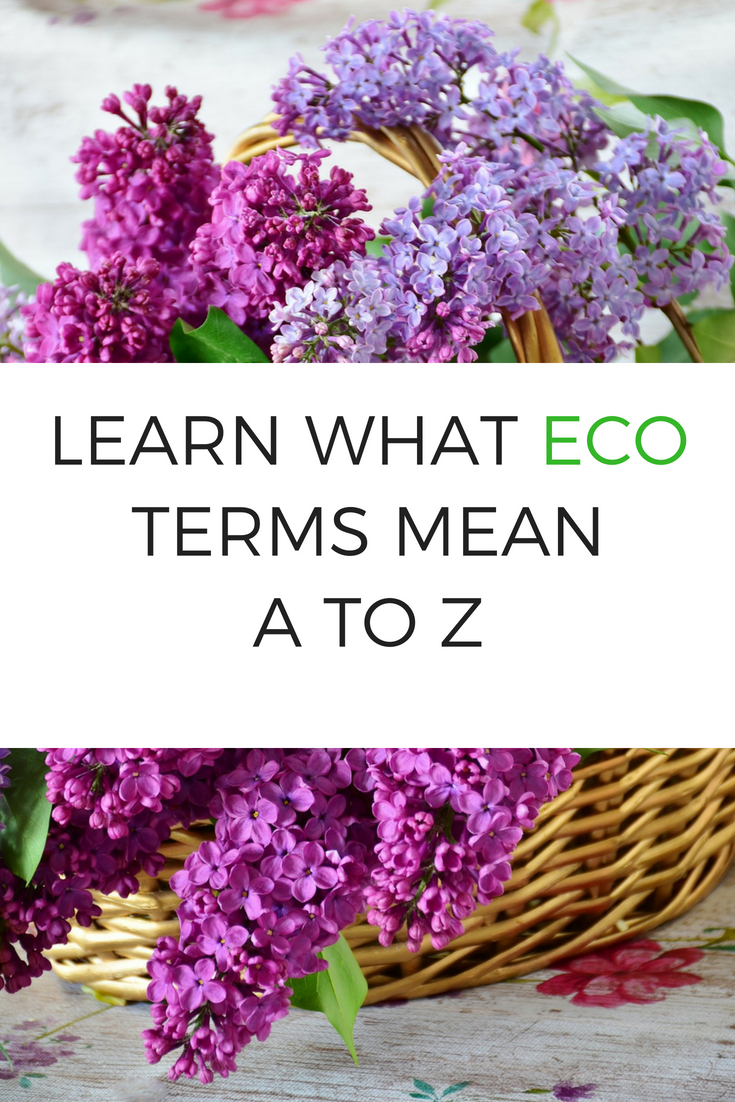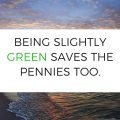I have pulled together a quick A to Z of eco terms as found myself confused and lost on the terms they use.
A is for an alternative living – alternative living is the eco thinking way of living: by means of choosing to live in a green a way possible. It can the whole lot of only eating the food they have grown, making their own clothes and only using renewable sources of energy. Or it can be introducing elements of alternative living and becoming more eco-conscious about everything you do.
B is for biodegradable – Plastic bags, synthetics, plastic bottles, tin cans and computer hardware may make our lives easier but when they have been thrown away they do not break down naturally as they are not biodegradable. This means the landfill sites fill up and as the air, moisture, climate and soil cannot break them down naturally they cannot be dissolved in the surrounding land. Biodegradable products are made from nature and can be broken down again.
B is also for bio-fuels – A biofuel is a fuel that has derived from biomass. Like recently living organisms or their metabolic by-products like manure from cows. Bio-fuels are a renewable energy source so are as green as can be. They also have the advantage of being ‘carbon neutral’ as although burning them releases carbon into the atmosphere they aren’t damaging like fossil fuels. There are three categories of biofuels: solid, liquid and gas. The two most common liquid fuels are bio-diesel made from oil seeds and ethanol made from corn, sugar or grain and can be used as replacement for petrol.Â
C is for carbon footprint – Basically, your carbon footprint is how much carbon is emitted from your lifestyle – your own personal impact on the environment. Your footprint has two parts, direct footprint, and indirect footprint. Your direct footprint is things like using your car. Your indirect footprint is the things like buying biodegradable and buying local produce.
C is also for climate change – this the effect human behavior has on the global climate due to emissions of greenhouse gases.
C is also for CO2 emissions – if you weren’t paying attention in chemistry at school, CO2 is the chemical symbol for carbon dioxide. It’s quoted alongside environmental issues because the CO2 emissions have become the most common of the greenhouse gases to contribute towards global warming.
D is for doing what you can – every bit by every person helps. If your not as green as your neighbors its nothing to get stressed about as long as you are doing what you can.
E is for eco-warrior – it may pleasantly surprise you that an eco-warrior doesn’t have to have hairy armpits, have unwashed hair and only live in trees. They can be smartly dressed businessmen and women to the little old lady down the road. They are though taking direct action to halt, suspend or otherwise stop an activity that adversely impacts the environment.
E is also for energy saving – these are the bits like turning up the heat instead of putting on a jumper or driving in the car when the journey is short enough and practical enough to walk it instead.
E is also for ethical – this is when you buy produce or clothing that haven’t been sewn or made by a child/person working long hours, poorly paid in terrible conditions. Also knowing your money hasn’t inadvertently gone towards chopping down rainforests or buying weapons but is doing something good and decent for the environment.
F is for fair-trade – fair-trade mark is an independent consumer label which appears on products as a guarantee that disadvantaged producers/farmers in the devolving world are getting a better deal. For a product to display this mark it must meet international standards set by the international certification board.
F is also for food miles– simply the distance a food travels from field to plate. Food now accounts for nearly a third of all goods transported across the world by road and by air and this travel adds to the carbon dioxide emissions that contribute towards climate change.
G is for global warming – the steady and documented rise in the earth surface temperature over the last century. Climate change is in turn linked to global warming.
G is also for GM food – GM stands for genetically modified foods, which are foods that have been artificially changed by scientists. Like tomatoes to be redder. Research shows that they could damage our health.
G is also for greenhouse gases – these are the gases that trap the sun’s heat in the atmosphere, leading to a rise in global temperatures that they can cause unpredictable climate change. The gases caused by a variety of human behavior such as the burning of fossil fuels, air travel, and car use are carbon dioxide, nitrous oxide and methane.
H is for housework – doing housework the eco-friendly way goes a long way towards doing your bit for the environment. By buying or making your own eco friendly eco products not only ensure less pollution going down the drain and into the sewer but also a home with clean air. Also, a less toxic environment will, in turn, improve sleep and concentration.
J is for junk mail – more than 100 million trees of junk mail is delivered in America every year. To produce that amount of paper, the pulp processing requires 114 billion litres of water. To make matters even worse most of the junk mail goes straight in the bin and not even recycled.
K is for Kyoto – Kyoto protocol is an international agreement based on stopping climate change reached in Kyoto in 1997. It established specific targets and timetables for reductions in greenhouse gas emissions to be achieved y all signatories. Eighty four other countries have now signed the Protocol.
L is for litter – as well as smelly and not nice to see it is also harmful to the environment as most of it isn’t biodegradable.
M is for mobile phones – although they can be recycled, few people do. The main wastage is on recharging the phones as ninety-five per cent of the energy used when a charger is plugged in is wasted energy. Only five per cent of the energy is actually used to charge the phone, the rest is when the charger is left plugged in aft wards. That’s over 50,000 tonnes of carbon dioxide emissions that could be avoided if we just unplugged the charges after charging the phones.
N is for nappies – 95 percent of parents use deposable nappies with at least 90 percent of these nappies ending up on landfill sites. Although there is the full-blown washable route there is also the option for versions that use fewer or no super-absorbents or reusable types.
O is for organic – organic food is grown without the use of fertilizers and pesticides and all the animals are reared without the use of antibiotics. Organic also provides higher levels of vitamins and minerals and no controversial additives such as aspartame and hydrogenated fast and no GM ingredients.
P is for parabens – parabens are the most commonly used preservatives in cosmetic, personal care and toiletry products. It was thought that it could link to a number of illnesses due to parabens mimicking the female hormone oestrogen. However, the studies are small and not proven.
P is also for pollution – air pollution usually comes from the fumes released from burning fuel. Water pollution is all the dirty water and fluids from our houses and factories. What you pour down the sink and flush away as is ends up in the rivers and oceans eventually.
R is for recycling – recycling isn’t just about the win bottles and newspapers. In reality, nearly everything can be recycled or reused. It just takes a bit of effort to think before you bin.
R is for renewable energy – As fossil fuels run out, everyone’s looking for a better source of energy that quickly replenishes itself and can be used again and again. There is wind power-harnessing the power of the wind, solar power-converting sunlight into electricity, hydro power-which has already been used for over 100 years and geothermal power-which comes from hot rocks deep underground.
S is for seasonal foods – by buying seasonal food you are buying food that has probably traveled fewer miles and had less effect on the environment.
T is for toxins – toxins are agents capable of causing our bodies harm. External toxins come from external sources like car fumes, smoking, pollution etc. If you want to reduce the toxins in your body, you need to think about everything from your lifestyle choices to the way you live your life.
V is for VOCs – VOCs are volatile organic compounds and are known irritants. Sources include solvents, floor adhesives, paint and cleaning products. The problem with VOCs is the associated health effects like headaches, dizziness, and asthma and skin irritations. To reduce the risks make sure there is plenty of fresh air when using these products and throw away unused containers safely.
W is for waste– waste is everything we throw away and considering just about everything we do produces waste then the problem is that we are throwing away in such quantities that we are putting pressure on the environments ability to cope. We all need to cut our waste by buying and throwing away less.
W is also for water – we all wastewater all the time. Dripping taps, leaving taps on as we brush our teeth, taking baths instead of showers.

LEARN WHAT ECO TERMS MEAN A TO Z 1


Leave a Reply